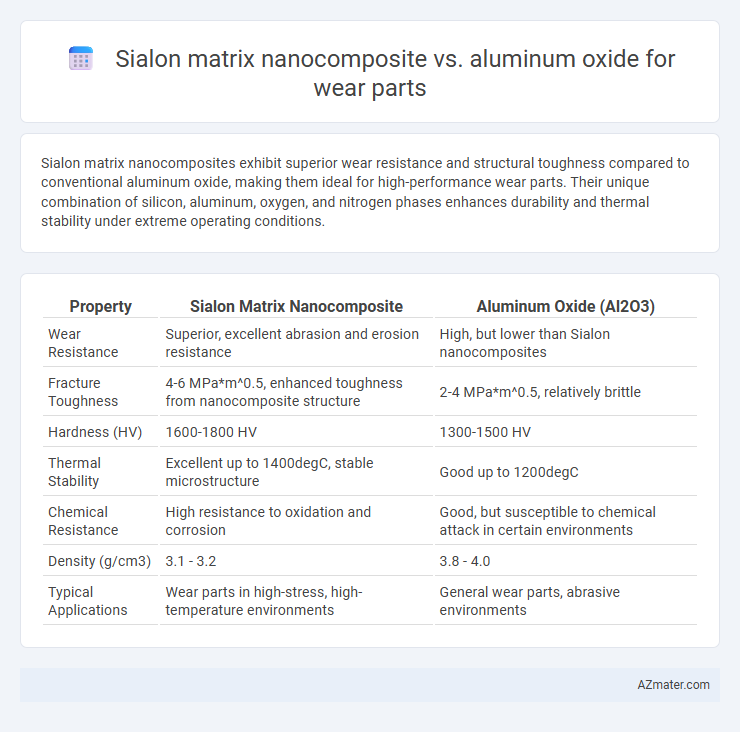Sialon matrix nanocomposites exhibit superior wear resistance and structural toughness compared to conventional aluminum oxide, making them ideal for high-performance wear parts. Their unique combination of silicon, aluminum, oxygen, and nitrogen phases enhances durability and thermal stability under extreme operating conditions.
Table of Comparison
| Property | Sialon Matrix Nanocomposite | Aluminum Oxide (Al2O3) |
|---|---|---|
| Wear Resistance | Superior, excellent abrasion and erosion resistance | High, but lower than Sialon nanocomposites |
| Fracture Toughness | 4-6 MPa*m^0.5, enhanced toughness from nanocomposite structure | 2-4 MPa*m^0.5, relatively brittle |
| Hardness (HV) | 1600-1800 HV | 1300-1500 HV |
| Thermal Stability | Excellent up to 1400degC, stable microstructure | Good up to 1200degC |
| Chemical Resistance | High resistance to oxidation and corrosion | Good, but susceptible to chemical attack in certain environments |
| Density (g/cm3) | 3.1 - 3.2 | 3.8 - 4.0 |
| Typical Applications | Wear parts in high-stress, high-temperature environments | General wear parts, abrasive environments |
Introduction to Wear Parts in Industrial Applications
Wear parts in industrial applications demand materials with exceptional hardness, thermal stability, and wear resistance to withstand harsh operational environments. Sialon matrix nanocomposites exhibit superior fracture toughness and improved resistance to thermal shock compared to traditional aluminum oxide, making them ideal for high-performance wear parts. These nanocomposites provide enhanced durability and longer service life in industries such as mining, metal processing, and manufacturing, where abrasive and impact wear are critical factors.
Overview of Sialon Matrix Nanocomposites
Sialon matrix nanocomposites exhibit superior wear resistance compared to aluminum oxide due to their enhanced fracture toughness and thermal stability, making them ideal for demanding wear parts. Their unique combination of silicon, aluminum, oxygen, and nitrogen atoms at the nanoscale leads to improved mechanical properties and resistance to abrasive and adhesive wear mechanisms. These nanocomposites maintain performance under high-stress conditions, surpassing traditional aluminum oxide ceramics in lifespan and durability for industrial applications.
Properties of Aluminum Oxide Ceramics
Aluminum oxide ceramics exhibit exceptional hardness, high wear resistance, and excellent thermal stability, making them ideal for wear parts in abrasive environments. Their chemical inertness and resistance to corrosion further enhance durability under extreme conditions. Compared to Sialon matrix nanocomposites, aluminum oxide offers superior hardness but may have lower fracture toughness and impact resistance.
Mechanical Strength Comparison
Sialon matrix nanocomposites exhibit significantly higher mechanical strength compared to aluminum oxide, making them ideal for demanding wear parts. The superior fracture toughness and flexural strength of Sialon, often exceeding 700 MPa flexural strength, enhance its resistance to cracking and wear under high-stress conditions. In contrast, aluminum oxide typically offers lower toughness and is more prone to brittle failure, limiting its durability in abrasive environments.
Wear Resistance Performance
Sialon matrix nanocomposites exhibit superior wear resistance compared to aluminum oxide due to their enhanced fracture toughness and higher hardness levels, which effectively reduce material degradation under abrasive conditions. The unique nanostructured Sialon matrix promotes better load distribution and limits crack propagation, resulting in prolonged service life for wear parts. Experimental data show Sialon composites outperform aluminum oxide in high-stress, high-wear environments, making them ideal for demanding industrial applications.
Thermal Stability and Shock Resistance
Sialon matrix nanocomposites exhibit superior thermal stability compared to aluminum oxide, maintaining structural integrity at temperatures exceeding 1400degC, which is critical for high-temperature wear parts. The thermal shock resistance of Sialon composites surpasses that of aluminum oxide due to their lower thermal expansion coefficient and enhanced fracture toughness, reducing the risk of crack formation under rapid temperature changes. This combination of high thermal stability and shock resistance makes Sialon nanocomposites ideal for demanding wear applications in harsh thermal environments.
Chemical Durability in Aggressive Environments
Sialon matrix nanocomposites offer superior chemical durability compared to aluminum oxide in aggressive environments due to their enhanced resistance to oxidation and corrosion at elevated temperatures. The silicon, aluminum, and oxygen-based structure of Sialon provides improved stability against acids, alkalis, and molten metals, extending wear part lifespan significantly in harsh chemical conditions. Conversely, aluminum oxide tends to degrade faster when exposed to strong corrosive agents, reducing its effectiveness in highly aggressive industrial settings.
Cost Analysis and Manufacturing Considerations
Sialon matrix nanocomposites offer superior wear resistance and thermal stability compared to aluminum oxide, making them ideal for high-performance wear parts despite higher initial material costs. Although the fabrication of Sialon nanocomposites involves complex sintering processes and specialized equipment, advancements in manufacturing techniques have gradually reduced production expenses. Aluminum oxide remains cost-effective and easier to process at scale, but may require more frequent replacements due to lower toughness and wear resistance, impacting overall lifecycle costs.
Application Suitability: Sialon vs Aluminum Oxide
Sialon matrix nanocomposites exhibit superior wear resistance and thermal stability compared to aluminum oxide, making them ideal for high-stress wear parts in aerospace and automotive industries. The enhanced fracture toughness and lower density of Sialon improve durability and reduce component weight, directly benefiting applications requiring high-performance and lightweight materials. Aluminum oxide remains suitable for moderate wear conditions but lacks the mechanical robustness of Sialon nanocomposites under extreme mechanical or thermal loads.
Future Trends in Advanced Wear-Resistant Materials
Sialon matrix nanocomposites demonstrate superior wear resistance and thermal stability compared to traditional aluminum oxide, making them ideal for high-performance wear parts in extreme environments. Future trends emphasize the development of Sialon-based composites with enhanced toughness and reduced friction through nanoscale reinforcement and tailored microstructures. Innovations in sintering techniques and hybrid composites are driving increased adoption of Sialon materials in industries requiring long-lasting, wear-resistant components.

Infographic: Sialon matrix nanocomposite vs Aluminum oxide for Wear part
 azmater.com
azmater.com